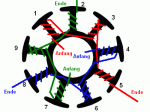mbrooke
Batteries Included
- Location
- United States
- Occupation
- Technician
Going by this diagram, how would this particular motor function? Would the rotor be pulled around toward the stator in an elliptical or off center orbit while spining slower? Would there be postive, negative or zero sequnce current in the squirrel cage rotor? What about the stator? Or would the combined magnetic field of the red and green phase equal the blue phase when said blue phase is at its peak in the sine wave?
I could be wrong, but I don't see a symmetrically rotating magnetic field...

I could be wrong, but I don't see a symmetrically rotating magnetic field...


